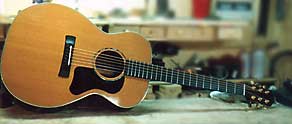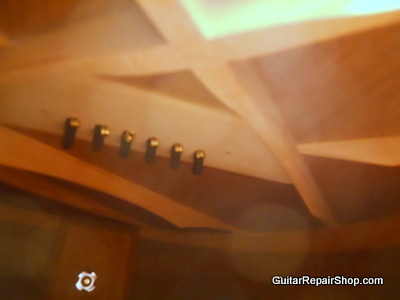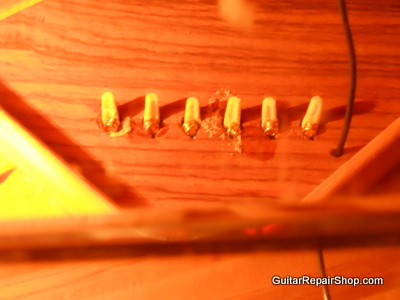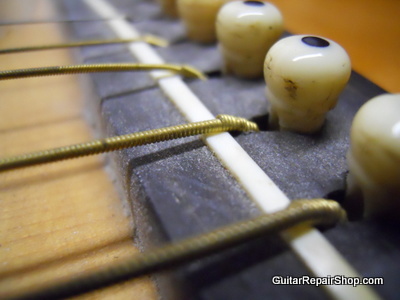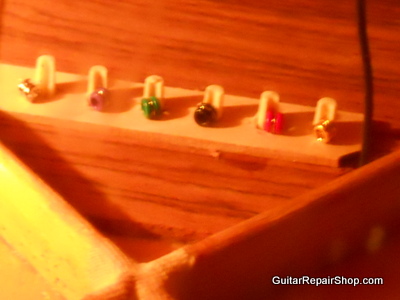|
| Repair Articles |
|---|
| Ask The Repairman |
| Repair Blue Book |
| Hardware Parts Accessories |
| Electronics |
| Guitar Wood and Kits |
| Tools |
| Friends |
|
|
|
|
|
A Remedy For Worn Bridgeplates - The Bridgeplate CapBy Steve Carmody c. 2015Does the tone of your guitar, particularly the mids and highs, seem to have gotten muddy over time? Does your guitar not seem to ring out as loud as it used to? Is the bridge beginning to separate from the top? Are there hairline cracks forming between the bridge pins? If any of these issues apply to your guitar, the string holes in your bridgeplate may have have gotten so worn that the ball-ends of the strings are pulling up through the top and are no longer anchoring tightly against the bottom of the bridgeplate. The bridgeplate is a veneer of wood, often maple or rosewood, that is glued to the underside of the top just under the bridge. It can almost double the thickness of the top in this area. The bridgeplate lends necessary strength to this part of the guitar, which must resist the pulling force of around 180 lbs. of pressure from the tensioned strings. The bridgeplate also serves as an anchor for the ball-end of the strings on a guitar with a pin-style bridge. Below is a picture of the inside of a guitar with a pin-style bridge which has a maple bridgeplate. The bridgeplate is located just below the junction of the main X-braces. On the outside, the bridge sits directly above it. Note the nicely anchored string ball-ends on this guitar.
When a pin-style bridge is installed, 3/16 inch holes are drilled through the top and bridgeplate to accommodate the bridge pins and strings. Over time, because of careless restringing, improper placement of the bridgepins or the use of the wrong style or size of bridgepins, the holes can wear away and expand, such that ball-ends of the strings, which should seat snuggly against the bridgeplate, start to pull up into the holes. This can have a number of negative effects on the guitar. One effect is that the pressure from string tension, instead of being spread across the bridgeplate, focusses more specifically on the bridge. Eventually, this can cause the bridge to begin to lift from the top. In some extreme cases, the bridge, the bridgeplate and even the top may crack. Another effect is that the tone of the guitar can lose clarity in the mids and highs, the guitar sounds muddy, and volume can seem to be not as great as it once was. This is because when the strings are not securely anchored, they are not transferring the energy across the top efficiently. Strings can also slip more easily out of tune or it may even be harder to reach the desired pitch, again, since the ball-ends are not firmly anchored. In the picture below, we are looking inside a guitar at the bridgeplate area. This bridgeplate is made of rosewood. Notice that the ball-ends of the strings, which, instead of anchoring nicely against the top, are pulling up into the string holes. If you look closely you can see that this bridgeplate has string holes that were slotted, but solid bridge pins are not being used. In this case, because of long-time wear, the string holes are enlarged and can no longer retain the ball ends of the strings, and even solid bridge pins will not properly anchor the string ball-ends ( I tried).
Warning SignsOne sign, from the outside, of worn bridgeplate string holes is that the overlapped windings of the string, at the bottom near the ball-ends, can be seen above the bridge pin holes, sometimes riding over the bridge saddle itself.
As mentioned earlier, other possible indications of worn bridgeplate string holes are a bridge that is separating from the top, muddy tone and diminished volume. NOTE: There are situations where the windings at the bottom the strings may be visible above the bridge, giving the indication of worn bridgeplate holes, when in fact the bridgeplate is not damaged. And ultimately, an inspection of the interior of the guitar with a mirror may be necessary to confidently diagnose whether there is actually an issue with the bridgeplate. Here are three examples: Sometimes the bridge pins themselves are shrunken or worn and are allowing the ball-ends to slip past them. Replacing the bridge pins will resolve this situation. Next, some bridge pin holes are slotted on the saddle side. The Martin company used this approach for many years. With slotted bridge-pin holes, the strings are supposed to be forced into the string hole slots by the bridge pins. Slotted bridge pins should not be used on these bridges since they will not push the strings into the slots. In these cases, the ball-ends pulling through can be resolved by either turning the slotted pins around, so the slots face the back of the string holes, or, preferably, by using solid bridge pins. The last case would be a guitar with a relatively thin bridge. In these cases the strings may be well anchored on the inside, but the windings at the bottom of the strings are still seen riding above the top of the bridge. If the thicker part of the strings actually ride over the saddle ( which is not always the case), even though the bridgeplate is not worn it can be advisable to glue a thin veneer of wood over the bridgeplate (we call this a bridgeplate cap- see description in next section) to seat the ball-ends lower and effectively draw down the thicker part of the string off of the saddle. It is better not to have this thicker part of the string sitting on the saddle since the intonation of the string can be affected.
RemedyThere are two standard remedies for repairing a worn bridgeplate. The first remedy is to remove and replace the entire bridgeplate. Removing the bridgeplate can be done on most guitars, but it is a challenging (and, in turn, costly) procedure which can often result in damage to the top. A more straightforward, less invasive, less challenging approach is to fabricate and install a small veneer of maple or rosewood (some folks use ebony or locust or walnut) over the string holes, and then redrill the holes. This (as mentioned earlier) is called a bridgeplate cap. In my opinion, capping the bridgeplate yields just as good a result (securely anchored strings) as replacing the entire bridgeplate, with much less risk of damage to the instrument. Some purists argue that the extra veneer of wood can potentially alter the tone of the instrument in a negative way, or that it simply detracts from the original, design/styling of the guitar and therefore should not be done. In my experience, the tonal difference between a guitar with a single-layer, unworn bridgeplate versus one with a small veneer over the string holes is hard to determine. What I can say with confidence is that guitars with worn bridgeplate string holes often suffer from poor tone and diminished volume, and capping the bridgeplate to provide a secure anchor for the string ball-ends greatly improves the guitar's tone, and volume. As for the alteration in the original styling. On a valuable vintage instrument, I can see the argument for a complete replacement by a confident professional, maybe. But short of this scenario, and unless the bridgeplate is cracked or warped, I do not think a complete replacement is necessary, or even a good idea. Fabrication of a bridgeplate cap is straightforward. A piece of suitable wood is sized to a thickness of about .100 inch, or slightly thinner. Then it is shaped to slightly larger than is necessary to cover the worn string holes. It is then glued into place using one or more long throated C-clamps. I like to use hide glue since the cap can easily be removed at a later time. After the glue dries, the string holes are re-drilled. Below is a picture of the guitar shown earlier, with a bridgeplate cap installed. Note the nicely anchored string ball-ends.
Steve Carmody is an independant guitar repairman and luthier with a shop in Silver Spring, Md. He has been doing guitar repair and restoration full-time since 1990. Questions about this article or anything else related to guitar repair? Send e-mail to - GuitarRepairShop@gmail.com |
